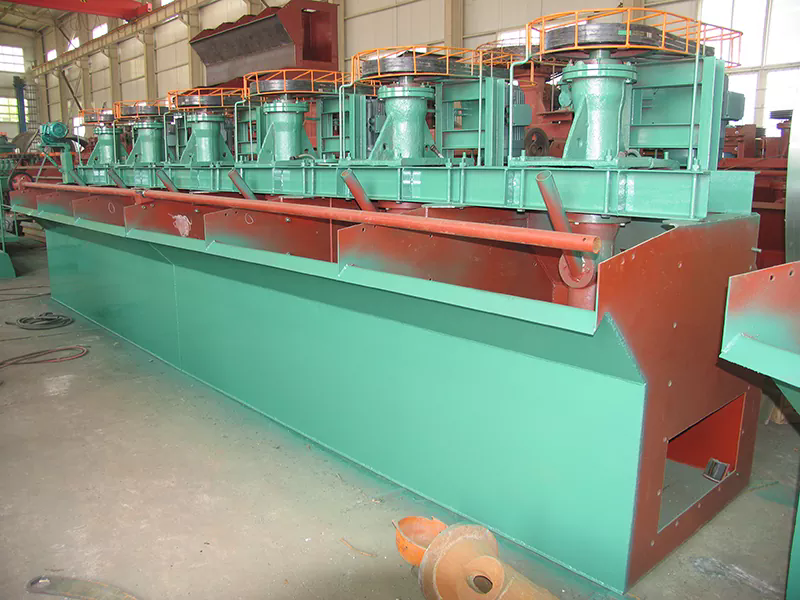 English
English Español
Español  Português
Português  русский
русский  Français
Français  日本語
日本語  Deutsch
Deutsch  tiếng Việt
tiếng Việt  Italiano
Italiano  Nederlands
Nederlands  ภาษาไทย
ภาษาไทย  Polski
Polski  한국어
한국어  Svenska
Svenska  magyar
magyar  Malay
Malay  বাংলা ভাষার
বাংলা ভাষার  Dansk
Dansk  Suomi
Suomi  हिन्दी
हिन्दी  Pilipino
Pilipino  Türkçe
Türkçe  Gaeilge
Gaeilge  العربية
العربية  Indonesia
Indonesia  Norsk
Norsk  تمل
تمل  český
český  ελληνικά
ελληνικά  український
український  Javanese
Javanese  فارسی
فارسی  தமிழ்
தமிழ்  తెలుగు
తెలుగు  नेपाली
नेपाली  Burmese
Burmese  български
български  ລາວ
ລາວ  Latine
Latine  Қазақша
Қазақша  Euskal
Euskal  Azərbaycan
Azərbaycan  Slovenský jazyk
Slovenský jazyk  Македонски
Македонски  Lietuvos
Lietuvos  Eesti Keel
Eesti Keel  Română
Română  Slovenski
Slovenski  मराठी
मराठी  Srpski језик
Srpski језик
What Advantages, Functions, and Future Trends Make Flotation Cells a Key Choice in Modern Mineral Processing?
2025-11-18
Flotation cells are specialized mineral-processing equipment designed to separate valuable minerals from unwanted materials using the principle of selective hydrophobicity. In mining and metallurgical operations, flotation cells remain one of the most widely used separation technologies because they allow fine particles to be efficiently recovered in a controlled environment. The core objective of flotation equipment is to maximize recovery, reduce energy consumption, and produce high-purity concentrates that support downstream refining processes.
Key Product Parameters of Modern Flotation Cells
| Parameter | Description |
|---|---|
| Cell Capacity | Ranges from 0.5 m³ to 680 m³ depending on model and application |
| Air Dispersion Method | Forced-air, self-aspirated, or hybrid systems |
| Impeller Speed | Adjustable RPM for precise bubble generation |
| Power Consumption | Typically 0.5–2.0 kWh per tonne of processed ore |
| Material Construction | High-strength steel, rubber liners, wear-resistant polyurethane |
| Pulp Level Control | Automated or manual control for consistent froth stability |
| Application Range | Gold, copper, lead-zinc, nickel, phosphate, graphite, coal, rare earth minerals |
These parameters illustrate the level of sophistication required for a flotation cell to operate efficiently under varying mineralogical conditions. Understanding these specifics ensures proper selection for both small-scale beneficiation plants and large commercial processing operations.
Why Are Flotation Cells Essential in Mineral Processing and Why Do Industries Depend on Them?
Flotation cells have become indispensable because they offer selective separation, enhanced recovery efficiency, and adaptable configurations for complex ores. Industrial reliance on flotation technology continues to grow due to increasing ore complexity, greater global demand for metals, and sustainability expectations that require cleaner processing solutions.
Why Are Flotation Cells More Efficient Than Traditional Separation Methods?
Flotation cells utilize air bubbles to selectively attach to mineral particles that repel water. This hydrophobic behavior allows valuable minerals to rise to the surface while impurities sink. Compared with gravity separation or magnetic separation, flotation can efficiently process fine particles and ores with low mineral concentration.
Why Do Modern Flotation Cells Deliver Higher Recovery Rates?
The engineered design of today’s flotation cells—optimized impellers, advanced air dispersion systems, and digital monitoring—ensures precise bubble-particle contact. The stronger the particle–bubble attachment, the higher the recovery rate. This is particularly important for softer or finely disseminated minerals where traditional methods fall short.
Why Is Energy Efficiency a Driving Factor?
Mining companies face increasing pressure to lower operational costs and reduce environmental impacts. Flotation cells that minimize power consumption while improving recovery rates offer a competitive advantage. Advanced systems use optimized air delivery and reduced impeller turbulence, lowering energy use per processed tonne.
Why Do Environmental and Regulatory Factors Increase the Need for Flotation Technology?
Environmental regulations demand cleaner technologies, reduced tailings, and more efficient water usage. Flotation cells support these requirements through:
-
improved concentrate quality, reducing downstream emissions,
-
lower reagent usage, decreasing chemical waste,
-
optimized water recycling systems within flotation circuits.
How Do Flotation Cells Work and How Can Their Performance Be Optimized?
Flotation cells operate through a series of controlled steps involving slurry conditioning, air bubble generation, and froth removal. Understanding how these elements interact helps industries optimize performance and achieve predictable outcomes.
How Does the Separation Process Occur Inside a Flotation Cell?
1. Conditioning of the Pulp
Mineral slurry is mixed with reagents, including collectors, frothers, and modifiers. These chemicals alter the surface characteristics of minerals, enabling selective attachment to air bubbles.
2. Air Introduction and Bubble Formation
Air is dispersed into the slurry using either forced-air systems or self-aspirating mechanisms. Impellers break the air into fine bubbles, which are essential for maximizing particle contact.
3. Particle–Bubble Attachment
Hydrophobic particles adhere to air bubbles, forming aggregates that rise to the froth layer.
4. Froth Collection
The mineral-rich froth overflows or is mechanically removed. Tailings are discharged from the bottom of the cell for further processing or disposal.
How Do Operators Improve Recovery, Purity, and Efficiency?
-
Precise Pulp Level Control: Stabilizing the froth zone improves concentrate grade.
-
Impeller Optimization: Adjusting rotational speed enhances bubble size control.
-
Air Flow Regulation: Balances recovery rate and froth stability.
-
Reagent Optimization: Ensures efficient mineral selectivity.
-
Automated Sensors and AI-free Digital Monitoring: Real-time tracking of froth characteristics, cell performance, and circuit load.
How Do Flotation Cells Adapt to Different Mineral Types?
Modern flotation cells support a wide range of minerals thanks to adjustable parameters such as:
-
reagent dosing,
-
air rate,
-
froth depth,
-
impeller speed,
-
slurry density.
This adaptability makes flotation technology suitable for base metals, precious metals, industrial minerals, and even non-metallic materials such as coal and graphite.
Future Trends, Industry Outlook, FAQs, and Brand Conclusion
The global mining industry is moving toward greater automation, sustainability, and resource efficiency. Flotation cells are evolving to support these needs through advanced engineering and enhanced operational capabilities.
Future Trends Driving Innovation in Flotation Cells
1. Larger-Capacity Cells for Higher Throughput
Demand for higher production volumes is pushing manufacturers to develop flotation cells exceeding 650 m³. Larger cells reduce footprint, maintenance requirements, and energy consumption per tonne.
2. Enhanced Wear-Resistant Materials
Future flotation cells will incorporate advanced polymers, ceramics, and abrasion-resistant compounds that extend equipment lifespan and reduce downtime.
3. Smarter Process Control
Digital control systems, including sensors for froth imaging, air distribution, and slurry chemistry, are becoming standard. These improvements provide consistent, predictable output and minimize human error.
4. Lower Chemical Consumption
Refinements in reagent delivery and pulp control reduce the amount of chemicals needed for effective separation, lowering environmental impact.
5. Hybrid Air Dispersion Systems
Combining forced-air and self-aspirated designs results in optimized bubble generation under variable mineralogical conditions.
Common FAQs About Flotation Cells
Q1: What types of minerals can flotation cells process?
A1: Flotation cells can process a wide variety of minerals, including gold, copper, zinc, nickel, lead, graphite, rare earth elements, phosphate, coal, and various industrial minerals. Their adjustable operating parameters allow efficient separation across different mineralogical profiles, including finely disseminated ores.
Q2: What factors most influence flotation cell performance?
A2: Performance is primarily influenced by air distribution, bubble size, slurry density, reagent selection, impeller speed, and froth stability. Each factor impacts particle–bubble interactions, recovery rate, energy consumption, and concentrate grade. Proper calibration ensures consistent output and high mineral recovery.
Q3: How do flotation cells reduce operational costs for mining companies?
A3: Flotation cells reduce costs by improving recovery efficiency, minimizing reagent consumption, lowering energy usage through optimized air delivery, and reducing maintenance requirements with modern wear-resistant materials. Larger-capacity cells also minimize the total number of units required, reducing infrastructure and labor expenses.
Conclusion and Brand Mention
Flotation cells remain essential equipment in modern mineral processing, providing selective separation, high recovery rates, and adaptable performance for complex ores. With the mining industry moving toward larger-scale operations, sustainability goals, and digital optimization, flotation technology is expected to play an even greater role in future beneficiation processes. Reliable flotation equipment enables consistent output, reduced energy consumption, and enhanced mineral purity, which strengthens the efficiency of entire processing circuits.
As industries continue upgrading their mineral-processing systems, choosing dependable flotation solutions becomes crucial. EPIC provides professional, high-performance flotation cell equipment engineered for stability, efficiency, and long-term durability. For more information or technical consultation, contact us to discuss solutions tailored to your processing needs.





